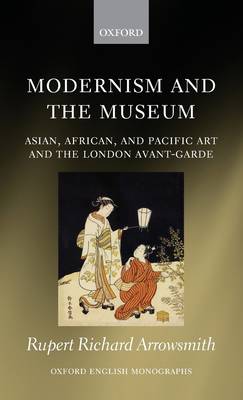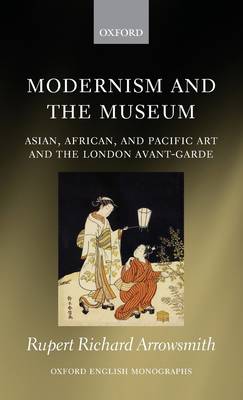
- Afhalen na 1 uur in een winkel met voorraad
- Gratis thuislevering in België vanaf € 30
- Ruim aanbod met 7 miljoen producten
- Afhalen na 1 uur in een winkel met voorraad
- Gratis thuislevering in België vanaf € 30
- Ruim aanbod met 7 miljoen producten
Zoeken
Modernism and the Museum
Asian, African, and Pacific Art and the London Avant-Garde
Rupert Richard Arrowsmith
€ 306,45
+ 612 punten
Omschrijving
Modernism and the Museum proposes an entirely new way of looking at the evolution of Modernist art and literature in the West. It shows that existing surveys of Modernism tend to treat the early stages of the movement as a purely European phenomenon, and fail to take account of the powerful and direct influence of Asia, Africa, and the Pacific islands operating via museums and exhibitions, particularly in London. The book presents the poet Ezra Pound and the sculptor Jacob Epstein as two seminal figures whose development of a Modernist aesthetic depended almost entirely on innovations adapted from extra-European visual art, and makes similar revelations about the work of related figures such as Henri Gaudier-Brzeska, Eric Gill, T.E. Hulme, Laurence Binyon, Richard Aldington, Amy Lowell, Charles Holden, William Rothenstein, Ford Madox Ford, James Gould Fletcher, James Havard Thomas, W.B. Yeats, and D.H. Lawrence. The writing is engaging, but the scholarship is rigorous, and a large quantity of previously unpublished evidence is made available from the British Museum, the Victoria and Albert Museum, the Royal Institute of British architects, the Tate Gallery, and several private collections. The book positions the museums of London - and especially the British Museum - as the West's most significant hub of transcultural aesthetic exchange during the early Twentieth century. It essentially proposes that, far from representing a development rooted in provincial European culture, Modernism was in fact the result of an unprecedented willingness in the avant-garde of the West to engage with the rest of the world.
Specificaties
Betrokkenen
- Auteur(s):
- Uitgeverij:
Inhoud
- Aantal bladzijden:
- 244
- Taal:
- Engels
- Reeks:
Eigenschappen
- Productcode (EAN):
- 9780199593699
- Verschijningsdatum:
- 8/03/2011
- Uitvoering:
- Hardcover
- Formaat:
- Ongenaaid / garenloos gebonden
- Afmetingen:
- 140 mm x 218 mm
- Gewicht:
- 453 g

Alleen bij Standaard Boekhandel
+ 612 punten op je klantenkaart van Standaard Boekhandel
Beoordelingen
We publiceren alleen reviews die voldoen aan de voorwaarden voor reviews. Bekijk onze voorwaarden voor reviews.








